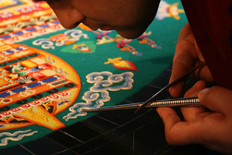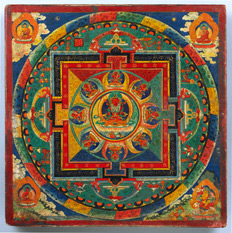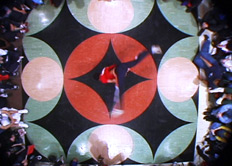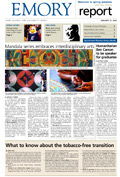Events
January 12, 2012
Mandala series embraces interdisciplinary arts

"The Mind's Eye" is a photo exhibit of Tibetan monks painting sand mandalas at Emory during Tibet Week 2010. (Photo by Myron McGhee)

"Mandala: Sacred Circle in Tibetan Buddhism" at the Carlos Museum will feature this mandala of Buddha Amitayus from 19th century Tibet.

The "Contemporary Mandala" show at the Visual Arts Gallery includes a performance space created by artist Sanford Biggers.
A perfect circle representing at once wholeness and infinity, the mandala straddles complex and sacred realms in Tibetan Buddhist tradition.
This spring, a series of exhibitions, educational programs and hands-on activities on campus will examine the historical and religious significance of the mandala as it relates to current artistic and cultural practices.
Anchoring the spring activities is a Michael C. Carlos Museum special exhibition, "Mandala: Sacred Circle in Tibetan Buddhism," from Jan. 21 to April 15. For the first time in the Southeast, more than 100 masterworks will illuminate the mandala as a tool for meditating and achieving enlightenment. Visitors will be dazzled by mandalas conceived as concentric circles, lotus blossoms, six-pronged stars and inverted, crossed triangles.
Among the objects on display will be a monumental, intricately-carved, three-dimensional mandala from the Gyuto Monastery in Dharamsala, India, which is being reassembled by local monks from Drepung Loseling Monastery. The Rubin Museum of Art in New York, which previously put on a similar exhibition, contributed many of the works to the Carlos exhibit, supplemented by works from private collections and from museums around the world.
"This exhibition has been the impetus for so much cross-disciplinary and university-wide arts programming," says Elizabeth Hornor, Marguerite Colville Ingram Director of Education for the Carlos Museum.
Coinciding with the dates of the Carlos exhibit, the Visual Arts Gallery will mount "Contemporary Mandala: New Audiences, New Forms." The exhibit will explore how contemporary artists address questions of transformation and balance in a multilayered society, using innovative materials to depict the mandala form. The centerpiece of the show is a dynamic performance space for visitors to interact with the mandala, created by New York artist and Morehouse College alumnus Sanford Biggers.
Through May 31, Cox Hall Computing Center will host "The Mind's Eye," a photo exhibit by Myron McGhee, a Pitts Theology Library staff member, presenting images of Tibetan monks painting sand mandalas during Emory's annual Tibet Week.
Tibet Week, scheduled for March 26 to 31 this year, is an outgrowth of the Emory-Tibet Partnership, which fosters dialogue between Western and Tibetan Buddhist traditions in science, philosophy, arts and culture.
Natural outgrowth of learning
Various mandala-related educational programs will be held at Emory, including a four-week Tibetan Buddhist compassion meditation class and an urban mandala arts activity co-sponsored by Emory's Office of Sustainability Initiatives, where participants will construct a giant mandala from natural and recyclable materials.
A separate living mandala made from perennial plants and flowers, created with the help of Emory students, is planned for the Pitts Garden of Cannon Chapel.
Emory has already established itself as a leader in Tibetan Studies abroad with its highly successful spring and summer programs in Dharamsala. Shortly after His Holiness the XIV Dalai Lama visited Emory in 2007, the University received a five-year grant from the Shelley and Donald Rubin Foundation to expand on Emory's robust public programming and undergraduate teaching in Tibetan studies.
"In Tibetan Buddhist practice, it is not uncommon for practitioners to imagine themselves as enlightened beings and then to visualize their bodies, environs and universe as vibrant mandalas," says Sara McClintock, associate professor of religion, who helped secure the Rubin grant and was involved in planning this year's Carlos exhibit.
This semester, McClintock, joined by Visual Arts Department Chair Julia Kjelgaard and Geshe Lobsang Tenzin Negi, chair of the Emory-Tibet Partnership and senior lecturer in religion, will teach the course, "Tibetan Mandalas." Students will learn how to construct a sand mandala and study the symbolism, construction and ritual use of mandalas in various forms.
While the confluence of mandala events this semester may seem serendipitous, Kjelgaard notes that they are a natural outgrowth of an interdisciplinary approach to learning.
"That's the kind of open-mindedness that we need to keep alive in our culture," Kjelgaard says. "All these things that appear very separate from one another are actually interrelated."

